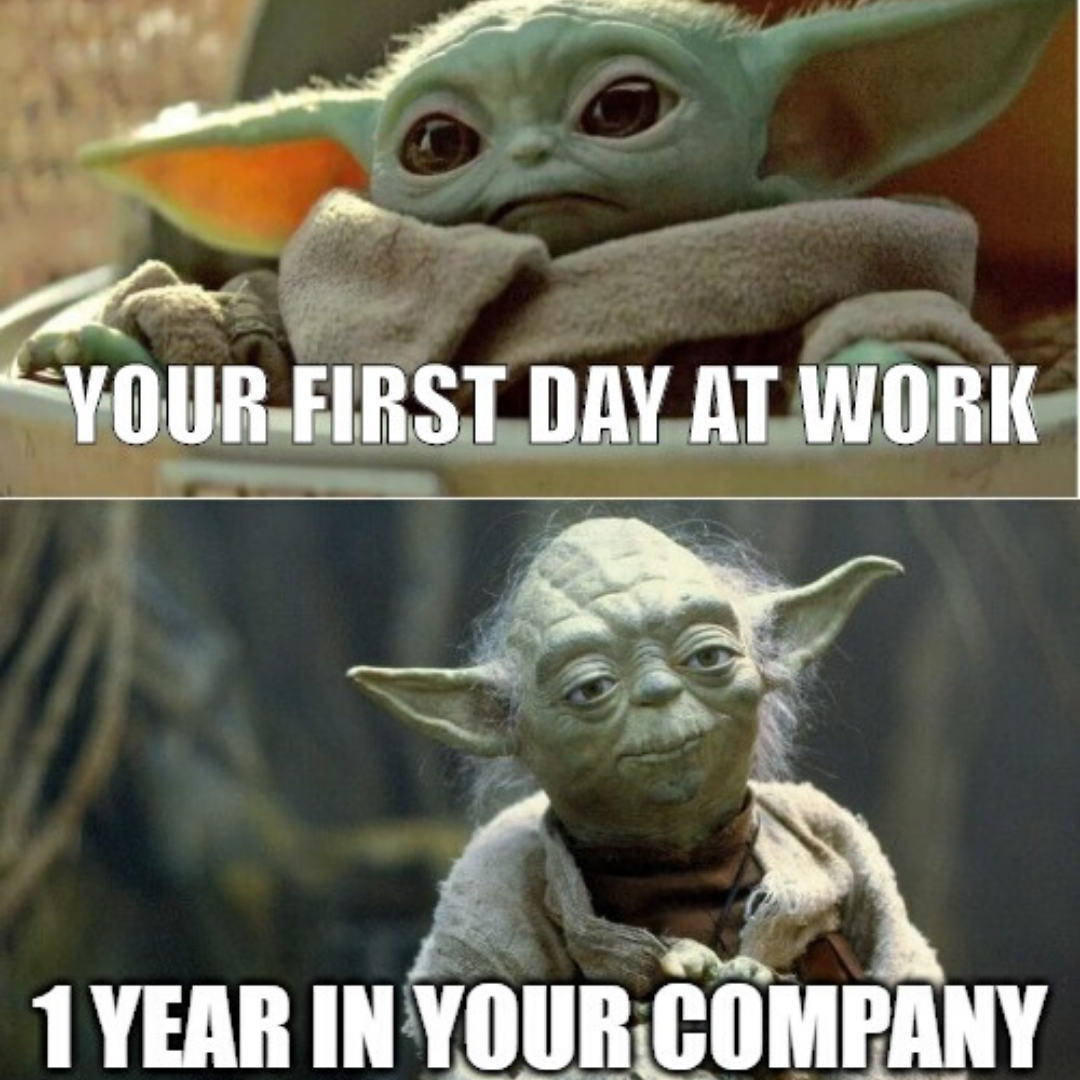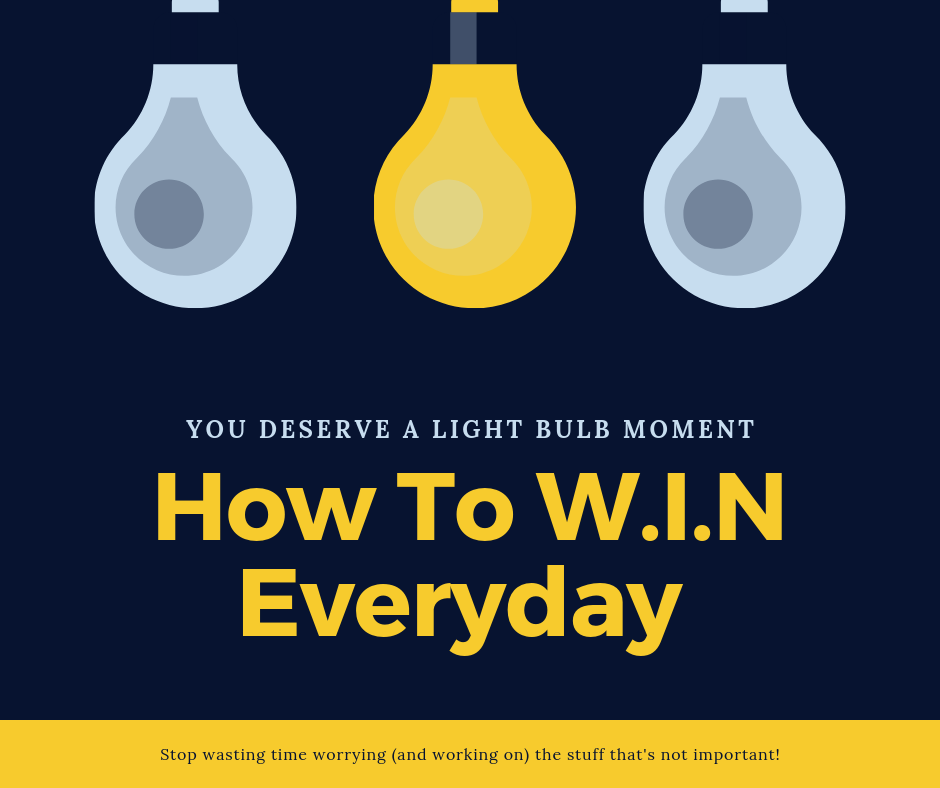When it comes to WIN’ing there’s a lot of noise online. I did this so you don’t have to, but if you Google’d WIN strategy you’d get all kinds of nonsense. You’d get scammy internet marketers trying to sell you winning online business blueprints, you’d get big-name management consulting firms trying to sell you their ideas about how you can create a winning proposal to land your next piece of business, and you’d see all kinds of generic win-win negotiation stuff. I don’t want to do any of that today. I’m not interested in selling you anything, well, maybe on the idea that you could benefit from thinking about what’s important at the moment more often.
Like I said, none of that noise is what we’re here today to talk about. For today W.I.N is an acronym for “what’s important now”. And believe it or not, it actually took me a few tries before I could even find any resources that mentioned this methodology as anything more than a stitched-together series of anecdotes or Instagram ready visuals. When you give it a few tries you might uncover that “what’s important now” was actually popularized (dare I say coined) by one of history's more colorful college football coaches, Notre Dame’s (along with a few others) Lou Holtz. We’re not going to talk about all of Coach Lou’s professional ups and downs but I do want to dig a little deeper into his “what’s important now” methodology.
Coach Lou was known to ask his players “What’s important now?” all the time. When they were struggling with their course loads, having personal issues, working on the field, and especially when it came to all the collegiate athletes being seduced with big dollars while still being in school.
Its impact was mirrored by how simple and straightforward the question was.
I already know what you’re thinking...You’re thinking about how you’re not a Notre Dame football player coming up in the mid-‘90s right now. And you’re right! But that doesn’t mean that good coaching should be kicked aside just because it’s from the era that gave us big-band ska music.
“Zoot Suit Riot” by Cherry Poppin’ Daddies anyone?
Instead of just leaving you with another generalization about how it’s important to check in with yourself and your business from time to time by asking “What’s important now?” let’s unpack it.
This question is often asked at a point of inflection or when a choice has to be made. But what about what happens before that? I’d argue that if you are just running around asking yourself “What’s important now?” you’ll be making all kinds of inefficient choices. When you answer that question without any context you’ll be making decisions based on the maximization of outcomes for wherever you happen to be at the moment.
That’s dangerous!
The thing that I think gets most overlooked when people recite a platitude like this from a guy like Coach Lou is the context for what’s going on in their lives or businesses. If we’re talking college football then those players had extreme routines, performance expectations, growth plans, goals, and were part of a system that was designed for them to put in the work (take massive action) necessary for them to be successful. Most of us don’t have the resources of a globally recognized institution, like Notre Dame, behind us when we’re trying to build our businesses but, that doesn’t mean we can’t create our own environments for success.
So how can you set yourself up so that when you ask yourself this question you’re not just leaning into the whims of the day?
By being strong in your mission, vision, and values. Sounds old-timey cliche but hear me out.
Business plans and written strategic plans are written (most of the time) for the benefit of investors, lenders, managers, and sometimes to just say that it’s been done. In my experience, they are very rarely relied on or even referenced when it comes to the day to day operations of a business. Don’t believe me, as I sit here literally editing this post Crash Course video just dropped with Anna Akana literally validating me. Here’s the link to the Crash Course YouTube video if you’re curious. Wait, finish here first actually then go! So sure, policies are followed and goals that are actually turned into activities that are measurable, that don’t have some ambiguous due date, and whose impact can be felt get worked on regularly. But what about everything else that goes into doing the real work of building something that’s sustainable and value-adding to the people you’ve committed to serving?
Enter mission, vision, and values.
These are the three pillars that represent how you and your business literally navigate in the world. Your belief system and everything that’s important to you is wrapped into a few different paragraphs and sentences. That’s a big deal! Subconsciously, if you have any amount of conviction behind these pillars you created there’s a good chance you’re already be measuring the decisions make them. Sometimes though, as good as our intentions are, dealing with the day to day grind can leave us possibly.
For the sake of this post, I’m going to give you the quick and dirty for getting clear on mission, vision, and value. For more detailed conversations or to dig a little deeper check out these other posts here at the Disruptive Strategy Co Blog.
Let’s get you resolute in your business and what’s important to you so that you have as good a chance as possible to make a great decision after you ask yourself “What’s important now?”
Mission
What is it: It answers the questions of “Who are you serving?” and “How are you serving?” for your business. Answering those questions while keeping your “why” in the frame will allow the people who find you to identify with you and the problem you’re solving. It’s short, direct and hopefully tugs at the heartstrings a bit.
Why is it important: A clear and specific mission sets the basis for alignment with the people you’re hoping to serve. It’s also the start of the framework you’ll use for future decision making. Your mission is you and your business planting your flag in the ground. You’re announcing to the world that there are a few things that are really important to you and that you’re committed to doing the work to facilitate change for people, solve a problem, etc.
Make it for yourself: Start by finding a few of your favorites. I love the Starbucks mission statement. It’s, “to inspire and nurture the human spirit – one person, one cup and one neighborhood at a time.” Nowhere in there does it say anything about coffee right? But it evokes emotion, digs a little deeper about what having a place to have coffee means to them and nods to the decisions they’ll make when it comes to big sweeping operational issues. This mission statement shows me that their biggest priority is creating a culture and it shows. There are no hard and fast parameters here but brevity wins. A sentence or two..or three is fine. Nowhere should be cheesy things like customer service, quality, loyalty, blah, blah, generic business-speak-encapsulating-what-people-already-expect-when-they-interact-with-you, blah.
Vision
What is it: This is the explanation around the impact you hope to have and what your business will look like in the future as you continue to solve problems and make people’s lives better. Think of it as a sentence or two that paints a picture of your company in the future.
Why is it important: It gives people the opportunity to see what you see, to participate in your quest for world domination making the world a better place. When Bill Gates started Microsoft his vision was simple, to make computing accessible to everyone. I think he’s been pretty successful with that so far. It should be easy to understand and visualize for everyone.
Make it yourself: Again look to your favorite brands. There are no hard parameters here either. I get a chuckle every time I see Amazon’s, “Our vision is to be Earth's most customer-centric company; to build a place where people can come to find and discover anything they might want to buy online.” Keep it brief, colorful and ideally relate-able so that when anyone else sees it they can nod their head and appreciate the impact you’re trying to have on the world.
Values
What is it: This one’s really easy to explain. Simply, these are your core principles or standards. These values are like bumpers at the bowling alley, they will guide you down the lane even if you didn’t have a good throw. Roll? Release? I should know more about bowling before I use it in a metaphor.
Why is it important: Your values are going to be the things that people give you the hardest time about and equally love you the hardest for. It can be very Charles Dickens at times. Your values are the biggest things that are important to you, the issues that you'll fight for and protect regardless of market conditions. People like us do things like this.
Make it yourself: This is where it gets a little challenging. With values, it’s really easy to talk a big game about how important communication is, what it means to show up every day, your commitment to actually serving people, etc… The hard part comes with doing the things you say you’re going to do. It’s only natural to get busy, have rough days and not feeling like showing up. It’s part of the process. The thing that will set you apart from the literal thousands of people trying to carve a place out in the hearts of your customers will be delivering on your values every single day. It’s going to be tough but that’s OK because you eat tough for breakfast and are in it to win it for the long game. Need a little help getting to the core of values, start with the businesses you buy from. For me, I’m a big fan of Amazon, Squarespace, ConvertKit, and a few local businesses. I gravitate towards them because they stand by what’s important to them and their values are in alignment with my own, on top of being really great value providers.
I know this is a long one today so if you’re still with me I just wanted to say thanks. To bring this home I want to challenge you this week. My challenge is that you look at your Trello boards, Asana projects, Google Calendar entries, and even your inbox and ask yourself - “What’s important now?” Not just as a way to prioritize your to-do list for the day but in a deeper way. Regardless of the tools used to help you be productive we all run into the same decision making and productivity constraints. There’s only so much productivity bandwidth you can give, sustainably, every day. So really look at everything you have going on and honestly try to evaluate which things are worth continuing to pursue and let go of the stuff that isn’t serving you anymore. Again, I totally get that it’s easy to say and way harder to do but trust me, you’ll feel a lot better, and will actually feel like you’re winning consistently when you get to focus on the important stuff.












